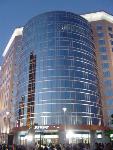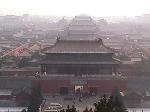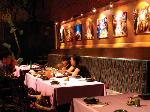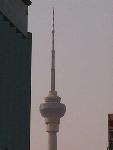- Getting around Lijiang. Dont stay in the Old Towns more than 2 days, there is nothing to do. KRISS Oct 9, 2013 05:46
- 2013 Beijing Temple Fair BENNYLAU Feb 26, 2013 03:29
- Malaysian traveling from KUL - LAX vis Shanghai PVG ZATI_DY Jan 3, 2013 20:15
When the Way Home is Home - Journey's End in Beijing
- Views: 2824
- |Vote: 0 0
- |Add to Favorites
- |Recommend to Friends
In Familiar Territory
To be once again in Beijing, swamped in the warming burrs of the Beijing dialect, wandering through crowds of exuberant young Chinese casually exchanging their good moods along Great Qianmen Road, I was uplifted, back in familiar surrounds, my Chinese North. My travelmate Steve and I had taken a comfortable overnight soft seat express train from Shanghai, and were headed for the Jinghua hotel, myself returning after two months in the South.
Poor travellers know the world as a stranger, visiting many places and photographing the odd and the unusual, the gaudy and the gorgeous, the gaunt faces of the poor and the toothless old women, telling tales upon their return of the awful, the exotic, the splendid and the difficult to imagine. To understand travel is to find the familiar in the far away, to know foreign places with the same intimacy as your home town. The travellers I have always respected are those who go not merely to witness but to enter and participate in a world that is always recognizable: such as these live in a condition of exploration every day of their lives.
To sign in once again to the Jinghua and relax at last was already like coming home. Our small dormitory was unisex on this occasion, the first time I’d seen men & women allowed to stay together in a hotel room since coming to China. The backpacker set is famously open-minded, if you believe the stories they tell – I wondered about where to change my clothes when the young British woman vacating the bed next to mine stripped off her pyjamas completely, slipped into pants and a T-shirt and then carried out her bags as if I wasn’t even there. The empty spaces were taken by a few similarly unselfconscious Japanese students.
Playing Tourguide
We arranged a visit to the Forbidden City, and I invited the newly arrived Japanese students to come along. Become something of a tour guide, I led our small party to the bus stop and we rode to Tiananmen Square. As we stood facing Tiananmen Gate, a curious old man wandered up and asked the Japanese students where Steve and I were from, and I had to correct his assumption that our friends were Chinese: he laughed good-naturedly at the strange reversal of roles; a Caucasian interpreting for Asian tourists.
The Forbidden City was even more sterile in the summer heat, and it was the second time I’d failed to be awe-struck by the fascinating history seemingly shrink-wrapped in the renovated buildings. I was supposed to be imagining the community of Eunuchs, Mandarins and Concubines fulfilling the every waking need of the Emperors, but instead I could only feel something more financial in nature. The site is one of the most enduring symbols of Chinese liberation, in that until the fall of the Qing Dynasty only the so-called nobility were granted access to it. China’s Government for the People, in allowing access to all, were giving the Heavenly Mandate to the People. Now as an international product, the site seems to have lost this newer, and more compelling, importance.
We swiftly moved on to the more immediately aesthetically appealing Jing Shan, a man-made hill to the north of the Forbidden City which served as a lookout, windbreaker and northern defence layer for the Emperor, who for geomantic reasons was obliged to reside in the Northernmost area of the palace rather than in the more defensible centre.
Jingshan is capped by a gorgeous short temple with a stunning view of the Forbidden City and Northern Beijing. From the top, I noticed the curious white pinnacle, the Lamaist Dagoba of Beihai Park, where we headed next. The park is a luxurious and quiet wander around a lake, The Dagoba sits on an island in the centre and is additional to the park entry fee; however, an unguarded gate to the back brought us a fairly close examination of the structure. We'd had a quick meal at KFC, which some locals regard as an eyesore squatting on their cultural heritage; McDonald's, and more recently Starbucks, spoil other sites of National importance. Way out at the back of the park we discovered the renowned Nine Dragon Wall, seemingly hidden so that only people who are trying to navigate the complicated pathways out of the park's rear gate might stumble across it. The wall is ornately decorated with sculptures of the said nine dragons on both sides, and is interesting in that one of the bricks is made of wood - the sculptor who was replacing the original brick had decided to cheat the emperor and pocket the cost of a stone brick, costing him his life when the trick was discovered - and it's a challenge trying to spot just which one it is. I had to be told.
Rather more appealing than all the historical areas was the adventure in interpreting the bus map to find a direct route back. It didn't prove to be difficult, and the streets to the north of the Forbidden City are genuinely appealing, old grey stone houses and stores, the smell of cooking on the street, colourful alleyways and dusty, tree-lined boulevards.
Summer Palace in Summer
The following day, Steve was visiting the Great Wall, and I decided to team up with my new friend Yumiko for another day’s sightseeing. Before long we were drinking blond beers together in Wangfujing’s snack alley and chatting with the Middle-Eastern looking Xinjiangese people serving kebabs. Yumiko was a student of Mongolian and Arabic, as well as being fluent in English, and was on her way to Hohhot in Inner Mongolia to meet with some real Mongol people. Japanese people are classically conservative, meaning that Yumiko was perhaps uncharacteristically charismatic; her casually comfortable nature was the mark of a genuine student of humanity and of a born traveller: at the same time, she was particularly susceptible to alcohol and needed to be supported all the way as we bussed to the Summer Palace, our next tourist destination.
I'd visited the palace first in the winter, and I had been more than charmed by it then - but perhaps it came more into its nature in the hot weather. The Summer Palace is the perfectly sculptured Chinese garden of fairytales made real; the great lake was a poetry of small boats, and the immense palace above it, with eaves of deep green gently lifting out from all sides like petals, was the Emperors’ magic castle. Yumiko sat on a stone looking joyously over the lake, her inquisitive face perfectly relaxed, grinning in the warm sunshine and under the passing seduction of her glass of beer.
Sanlitun
We met with Steve again in the evening, and decided to spend it in Sanlitun, the infamously seedy foreigner’s bar street. This time returning to Sanlitun, the centre of foreigner vice in all of Beijing, I was finally comfortable with the naughty, exuberant and subtly disturbing atmosphere. Sanlitun had come to represent for me the state of foreign exploitation of China today, and every time I saw the self-congratulatory Beijing laowai set - proudly gazing into the expensive beers and at the expensive lovers it was easy for them to afford - I felt some discomfort at the probability that local Chinese saw me as but one amongst them. This time in Sanlitun Yumiko’s presence deterred the 'ladybar' touts, who call at men without female company in order to sell them some - and we quickly found a quiet spot where Steve and I could enjoy conversation about our journey for the last time, as Yumiko negotiated another beer. Steve left later that evening to catch a flight out to London and the beginning of his European adventures. Like most travellers just passing through the PRC, he would always regard his brief experience in China as being indescribably special.
The TV Tower
I felt that it was particularly appropriate that the last attraction I would visit, on my last day in Beijing, was the TV Tower over the inner western suburbs. I have often written about these observation towers, from which all parts of a city can be seen in one instant – the vantage often providing a surprising insight that comes from piecing together all that you have done in the city until now as if all these moments were part of one single experience. Sitting in a café a few hundred metres above the city, I considered what Beijing has really become for foreigners, and what China may yet become in the immediate future. Beijing's West is another middle class haven, countless rows of apartment buildings, dust and shacks. From the top, Beijing is a featureless grey and squat plain of chubby square blocks. Night was falling as I watched - lit up, the city sectioned itself into arteries of wealth punctuating a desert of mediocre huts.
Beijing seemed to sit comfortably in my mind at last, I'd made another home of a foreign place. Modern cities like this one are layers of class and culture, and I was satisfied at having browsed the stack quite sufficiently for this visit.








 Copyright © 1998-2025 All rights reserved.
Copyright © 1998-2025 All rights reserved.